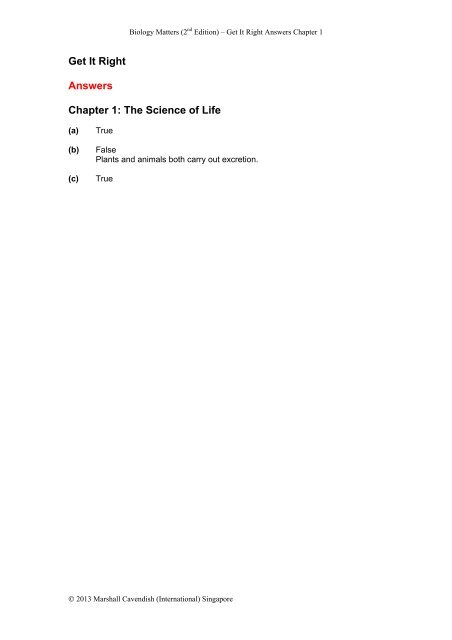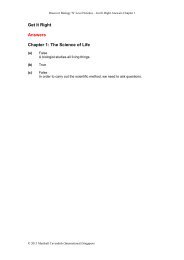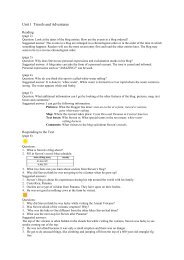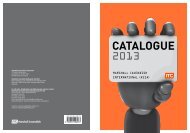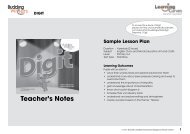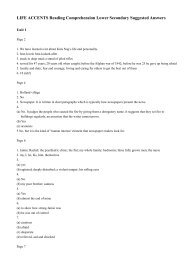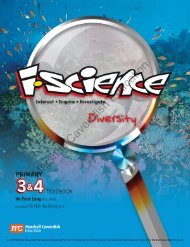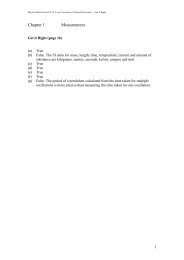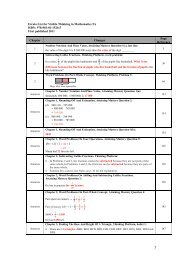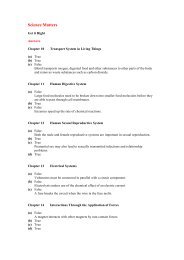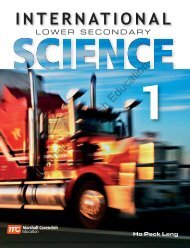Get It Right Answers Chapter 1 - Marshall Cavendish Education
Get It Right Answers Chapter 1 - Marshall Cavendish Education
Get It Right Answers Chapter 1 - Marshall Cavendish Education
You also want an ePaper? Increase the reach of your titles
YUMPU automatically turns print PDFs into web optimized ePapers that Google loves.
Biology Matters (2 nd Edition) – <strong>Get</strong> <strong>It</strong> <strong>Right</strong> <strong>Answers</strong> <strong>Chapter</strong> 4<strong>Get</strong> <strong>It</strong> <strong>Right</strong><strong>Answers</strong><strong>Chapter</strong> 4: Nutrients(a)(b)(c)(d)TrueFalseMaltose, lactose and sucrose are double sugars.FalseReducing sugars give a brick-red colour when boiled with Benedict’s solution.FalseStarch gives a blue-black colour with iodine solution.© 2013 <strong>Marshall</strong> <strong>Cavendish</strong> (International) Singapore
Biology Matters (2 nd Edition) – <strong>Get</strong> <strong>It</strong> <strong>Right</strong> <strong>Answers</strong> <strong>Chapter</strong> 5<strong>Get</strong> <strong>It</strong> <strong>Right</strong><strong>Answers</strong><strong>Chapter</strong> 5: Enzymes(a)(b)(c)(d)FalseEnzymes are biological catalyst, mainly made of proteins.FalseEnzymes work by lowering activation energy.TrueFalseDenaturation decreases enzyme activity.© 2013 <strong>Marshall</strong> <strong>Cavendish</strong> (International) Singapore
Biology Matters (2 nd Edition) – <strong>Get</strong> <strong>It</strong> <strong>Right</strong> <strong>Answers</strong> <strong>Chapter</strong> 6<strong>Get</strong> <strong>It</strong> <strong>Right</strong><strong>Answers</strong><strong>Chapter</strong> 6: Nutrition in Humans(a)(b)(c)(d)(e)FalseBile is produced in the liver but stored in the gall bladder.FalsePancreatic amylase digests starch to maltose.FalseThe small intestine and the colon absorb water and mineral salts.FalseMost of the absorbed sugars are stored as glycogen in the liver.FalseThe pancreas secretes the hormone insulin.© 2013 <strong>Marshall</strong> <strong>Cavendish</strong> (International) Singapore
Biology Matters (2 nd Edition) – <strong>Get</strong> <strong>It</strong> <strong>Right</strong> <strong>Answers</strong> <strong>Chapter</strong> 7<strong>Get</strong> <strong>It</strong> <strong>Right</strong><strong>Answers</strong><strong>Chapter</strong> 7: Nutrition in Plants(a)(b)(c)(d)(e)(f)TrueFalsePhotosynthesis releases oxygen gas.FalseConcentration of oxygen is not a limiting factor in photosynthesis.TrueFalseSpongy mesohpyll cells are loosely packed with numerous intercellularspaces for the diffusion of gases.FalseThe xylem vessels transport water and mineral salts.© 2013 <strong>Marshall</strong> <strong>Cavendish</strong> (International) Singapore
Biology Matters (2 nd Edition) – <strong>Get</strong> <strong>It</strong> <strong>Right</strong> <strong>Answers</strong> <strong>Chapter</strong> 8<strong>Get</strong> <strong>It</strong> <strong>Right</strong><strong>Answers</strong><strong>Chapter</strong> 8: Transport in Humans(a)(b)(c)(d)(e)(f)TrueFalseWhite blood cell consists of lymphocytes and phagocytes.TrueFalseThe human body adapts to high altitudes by increasing the number of redblood cells.TrueFalseAtherosclerosis refers to a condition where fatty substances are deposited onthe inner surface of the coronary artery, narrowing the lumen of the arteries.© 2013 <strong>Marshall</strong> <strong>Cavendish</strong> (International) Singapore
Biology Matters (2 nd Edition) – <strong>Get</strong> <strong>It</strong> <strong>Right</strong> <strong>Answers</strong> <strong>Chapter</strong> 9<strong>Get</strong> <strong>It</strong> <strong>Right</strong><strong>Answers</strong><strong>Chapter</strong> 9: Transport in Plants(a)(b)(c)(d)(e)FalsePhloem consists of sieve tube and companion cells.TrueFalseIons and mineral salts are absorbed mainly by active transport.FalseTranspiration pull is the main force that pulls water up the plant.True© 2013 <strong>Marshall</strong> <strong>Cavendish</strong> (International) Singapore
Biology Matters (2 nd Edition) – <strong>Get</strong> <strong>It</strong> <strong>Right</strong> <strong>Answers</strong> <strong>Chapter</strong> 10<strong>Get</strong> <strong>It</strong> <strong>Right</strong><strong>Answers</strong><strong>Chapter</strong> 10: Respiration in Humans(a)(b)(c)(d)(e)FalseIn anaerobic respiration in humans, no carbon dioxide is released.FalseAnaerobic respiration occurs in human muscles when muscular contractionsare so vigorous that maximum aerobic respiration is unable to release energyfast enough to meet the demand.FalseBreathing is different from respiration. Breathing refers to the muscularcontractions and movements of the ribs, which results in air moving in and outlungs. Respiration on the other hand is the oxidation (breakdown) of foodsubstances with the release of energy in living cells.FalseCarbon dioxide carried in the blood plasma is mostly in the form ofhydrogencarbonate ions.True© 2013 <strong>Marshall</strong> <strong>Cavendish</strong> (International) Singapore
Biology Matters (2 nd Edition) – <strong>Get</strong> <strong>It</strong> <strong>Right</strong> <strong>Answers</strong> <strong>Chapter</strong> 11<strong>Get</strong> <strong>It</strong> <strong>Right</strong><strong>Answers</strong><strong>Chapter</strong> 11: Excretion in Humans(a)(b)(c)(d)(e)(f)FalseAn example of excretion is the removal of urine from the human body.FalseUrea is produced in the liver and excreted in the kidneys.TrueTrueTrueFalseThe dialysis machine removes metabolic waste via diffusion while the kidneynephrons remove metabolic waste products through ultra filtration andselective reabsorption.© 2013 <strong>Marshall</strong> <strong>Cavendish</strong> (International) Singapore
Biology Matters (2 nd Edition) – <strong>Get</strong> <strong>It</strong> <strong>Right</strong> <strong>Answers</strong> <strong>Chapter</strong> 12<strong>Get</strong> <strong>It</strong> <strong>Right</strong><strong>Answers</strong><strong>Chapter</strong> 12: Homeostasis(a)(b)(c)(d)TrueFalseIn response to negative feedback mechanism, the effector organ will bringabout the reverse effect of the stimulus to restore the system to its originalstate.FalseThe main purpose of sweating is to remove excess heat from the body.FalseThe brain cannot consciously control body temperature regulation.© 2013 <strong>Marshall</strong> <strong>Cavendish</strong> (International) Singapore
Biology Matters (2 nd Edition) – <strong>Get</strong> <strong>It</strong> <strong>Right</strong> <strong>Answers</strong> <strong>Chapter</strong> 13<strong>Get</strong> <strong>It</strong> <strong>Right</strong><strong>Answers</strong><strong>Chapter</strong> 13: The Nervous System(a)(b)(c)(d)FalseNeurones are nerve cells. Nerve fibres are a part of the neurone.TrueFalseSensory, intermediate and motor neurones are not joined together. Thejunction between two neurones is called a synapse.True© 2013 <strong>Marshall</strong> <strong>Cavendish</strong> (International) Singapore
Biology Matters (2 nd Edition) – <strong>Get</strong> <strong>It</strong> <strong>Right</strong> <strong>Answers</strong> <strong>Chapter</strong> 14<strong>Get</strong> <strong>It</strong> <strong>Right</strong><strong>Answers</strong><strong>Chapter</strong> 14: The Human Eye(a)(b)(c)(d)FalseThe sclera protects the eyeball from mechanical damage.TrueFalseCones enable us to see colours in bright light.FalseTo focus on a near object, the ciliary muscles contract, the suspensoryligaments slacken and the lens becomes thicker and more convex.© 2013 <strong>Marshall</strong> <strong>Cavendish</strong> (International) Singapore
Biology Matters (2 nd Edition) – <strong>Get</strong> <strong>It</strong> <strong>Right</strong> <strong>Answers</strong> <strong>Chapter</strong> 15<strong>Get</strong> <strong>It</strong> <strong>Right</strong><strong>Answers</strong><strong>Chapter</strong> 15: Hormones(a)(b)(c)(d)TrueFalseResponses to the endocrine system can be slow and short-lived or fast andlong-lived.TrueFalseThe endocrine and nervous systems are two systems are not completelyindependent of each other.© 2013 <strong>Marshall</strong> <strong>Cavendish</strong> (International) Singapore
Biology Matters (2 nd Edition) – <strong>Get</strong> <strong>It</strong> <strong>Right</strong> <strong>Answers</strong> <strong>Chapter</strong> 16<strong>Get</strong> <strong>It</strong> <strong>Right</strong><strong>Answers</strong><strong>Chapter</strong> 16: Cell Division(a)(b)(c)(d)FalseEven when an organism stops growing, mitosis still occurs.FalseDuring interphase, the cell carries out activities like absorbing nutrients andbuilding up protoplasm.FalseJust like in mitosis, chromatin threads replicate right before meiosis I. In orderto ensure four haploid daughter cells are produced, there is no replication inmeiosis II.True© 2013 <strong>Marshall</strong> <strong>Cavendish</strong> (International) Singapore
Biology Matters (2 nd Edition) – <strong>Get</strong> <strong>It</strong> <strong>Right</strong> <strong>Answers</strong> <strong>Chapter</strong> 17<strong>Get</strong> <strong>It</strong> <strong>Right</strong><strong>Answers</strong><strong>Chapter</strong> 17: Reproduction in Plants(a)(b)(c)(d)(e)(f)FalseSexual reproduction can occur when there is only one flower present.FalseThe nucleus in the pollen grain is the male gamete.TrueFalseOffspring produced by self-pollination method are genetically dissimilar.TrueFalseWind pollinated flowers are flowering plants.© 2013 <strong>Marshall</strong> <strong>Cavendish</strong> (International) Singapore
Biology Matters (2 nd Edition) – <strong>Get</strong> <strong>It</strong> <strong>Right</strong> <strong>Answers</strong> <strong>Chapter</strong> 18<strong>Get</strong> <strong>It</strong> <strong>Right</strong><strong>Answers</strong><strong>Chapter</strong> 18: Reproduction in Humans(a)(b)(c)(d)(e)FalseSperm and urine passes out of the body through the urethra.TrueFalseOvulation occurs on day 14 in a 28-day menstrual cycle.TrueFalseHIV virus from the mother can affect the fetus.© 2013 <strong>Marshall</strong> <strong>Cavendish</strong> (International) Singapore
Biology Matters (2 nd Edition) – <strong>Get</strong> <strong>It</strong> <strong>Right</strong> <strong>Answers</strong> <strong>Chapter</strong> 19<strong>Get</strong> <strong>It</strong> <strong>Right</strong><strong>Answers</strong><strong>Chapter</strong> 19: Heredity(a)(b)(c)(d)(e)(f)(g)FalseAn organism possessing a dominant trait is not stronger than an organismwith a recessive trait.FalseHeterozygous parents may produce homozygous or heterozygous offspring.FalseCo-dominance can occur even when there is no multiple alleles present.TrueFalseMultiple alleles is a term used for a gene that exists in more than two alleles.FalseMutation can be detrimental or beneficial to the organism.True© 2013 <strong>Marshall</strong> <strong>Cavendish</strong> (International) Singapore
Biology Matters (2 nd Edition) – <strong>Get</strong> <strong>It</strong> <strong>Right</strong> <strong>Answers</strong> <strong>Chapter</strong> 20<strong>Get</strong> <strong>It</strong> <strong>Right</strong><strong>Answers</strong><strong>Chapter</strong> 20: Molecular Genetics(a) FalseEach nucleotide contains a deoxyribose sugar, a phosphate group and anitrogenous base.(b) FalseComplementary bases from the two DNA strands are joined together byhydrogen bonds.(c)(d)(e)TrueFalseThree DNA bases (one codon) codes for one amino acid.FalseThe vector used in producing genetically engineered human insulin gene is aplasmid.© 2013 <strong>Marshall</strong> <strong>Cavendish</strong> (International) Singapore
Biology Matters (2 nd Edition) – <strong>Get</strong> <strong>It</strong> <strong>Right</strong> <strong>Answers</strong> <strong>Chapter</strong> 21<strong>Get</strong> <strong>It</strong> <strong>Right</strong><strong>Answers</strong><strong>Chapter</strong> 21: Ecology(a)(b)(c)(d)(e)(f)(g)TrueTrueFalseA food chain is made up of producers and consumers.TrueTrueFalseIn the carbon cycle, decomposers release part of the energy in deadorganisms to the environment. Some energy remains trapped in the deadbody of the organisms.FalseCarbon sink stores more carbon than it releases.© 2013 <strong>Marshall</strong> <strong>Cavendish</strong> (International) Singapore
Biology Matters (2 nd Edition) – <strong>Get</strong> <strong>It</strong> <strong>Right</strong> <strong>Answers</strong> <strong>Chapter</strong> 22<strong>Get</strong> <strong>It</strong> <strong>Right</strong><strong>Answers</strong><strong>Chapter</strong> 22: Our Impact on the Ecosystem(a)(b)(c)(d)FalseNot all pollution results from human activities. Some causes of pollution arenatural.TrueFalseConservation is the protection and preservation of natural resources in theenvironment.True© 2013 <strong>Marshall</strong> <strong>Cavendish</strong> (International) Singapore


